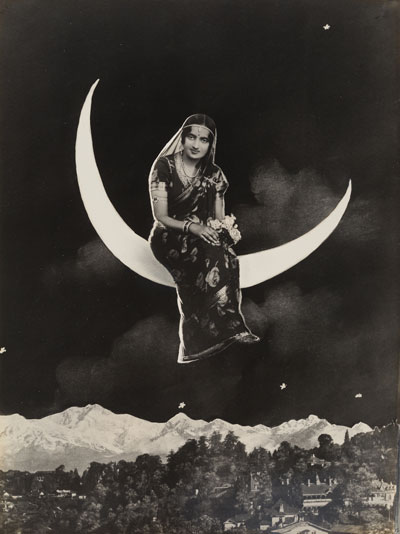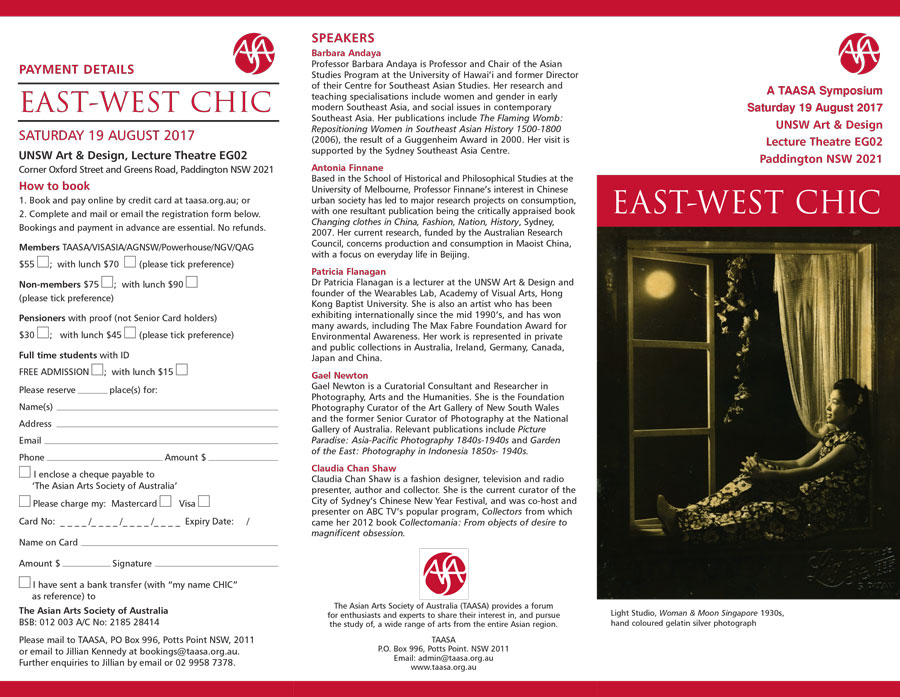Camera Chic
2017 presentation to TAASA : East West Chic
Gael Newton AM
Introduction
Surviving studio portraits capture the fashionable taste and aspirations of urban and regional centres across Southeast Asia from the late 19th century. Illustrated newspapers, and later movie stills, served to disseminate fashions globally, resulting in local hybrid styles that filtered modernity through creative mixings of traditional and Western styles and tastes. Studio sitters reflected changing fashions and values when they donned their own or hired dress for their portraits, as well as their individual aspirations to worldly success, recognition and social caché.
This talk examined the revealing insights that Asian studio portraiture presents into the changing self-image of individuals, the dynamics affecting groups and generations, and the fusion of East and West evident in dress, accessories, and studio backdrops.
click here for the images presented with the powerpoint presentation
The Presentation text
As a photo curator since the early 1970s my particular remit has been national surveys and the building of art museum collections from scratch. Firstly in Australian and photography then in Asia-Pacific.
From 2005-2014 my last curatorial adventure was the research and sourcing of a collection of the first century of photography from across the Asia-Pacific and in particularly within southeast Asia for the National Gallery of Australia.
That work resulted in two exhibitions Picture Paradise: Asia-Pacific Photography 1840s-1940s and Garden of the East: Photography in Indonesia 1850s- 1940s. Since leaving the National Gallery of Australia I have continued research and collection advice in Southeast Asian photohistory for Singapore museums and as a contributor to a Guimet museum publication. |
|
 |
One of my last acquisitions was of two albums on Javanese dance and landscape and culture by Italian photographer Tassilo Adam. I urge anyone with a student looking for a topic to contact me about these albums and Adam’s largely forgotten work of photographing and filming at the kratons of Java.
The TAASA journal has very kindly given me space to report at every stage on those activities over that entire period even though few members would have a particular interest in a western globally disseminated modern technology that would not be expected to have any significant local inflexions in technique or subject practise or consumption. I hope that my work has strengthened perception that despite the huge role of foreign photographers in the first half century to the 1890s that Asian born photographers collectively and individually were significant and indeed that Indonesian Kassian Cephas is I think a genius.
This month I received a request for biographies from Agence France for a forthcoming Dubai exhibition about 19th century photographers outside Europe that recognised the importance of a number of Asian photographers as much as expatriates abroad. I believe the vision of my former Director, Ron Radford, at National Gallery of Australia for an Asia-Pacific photo collection and his support for its realisation has played a part in changing international perceptions about the role of the local in the photographic practises in Asia. This is of course in concert with the intensified academic studies of the past two decades that has seen rich deeply detailed studies on photography in Asia.
It helps not being an academic. I have the luxury of confidently leap decades and countries in a sweeping sentence and as a consequence am also often invited to contribute to projects as specialists in one Asian country are wary of attempting to make comparisons with another that they no less about.
My presentation today is about a peripheral vision of the work on the Asia-Pacific collection as I developed an appreciation of studio portraiture in Asian ports for the general public and the early to mid 20th century colonial era family amateur album. Included in the large Indonesian collection we acquired from Leo Haks were 150 family albums. These are sadly not yet digitized but are a trove of images of life and custom in a space occupied by both Dutch residents and Indonesians. A chapter on these was included in Garden of the East by Australian scholar Susie Protschky.
In 2010 Luke Gartlan and I convened at the ANU “Facing Asia“ a seminar on early portraiture in Asia.
A select number of the papers have been published this year by Routledge Portraiture and Early Studio Photography in China and Japan co-edited by Gartlan with Roberta Wue. What is apparent in surveying Asian studio photography from the 1880s when modern studio portraiture of a reasonable size in the cabinet card within the means of a wide of social classes, is that the studio offered a space in which East and West met and tried each others clothes on.
The mode was an extension of the popularity of the commercial sale of carte de visites of stage stars since the 1860s but reaching a peak in the last decades of the 19th century when illustrated papers could reproduce photographs directly and had global circulation. There was also the sale of ‘types’ in the 1860s – when photographers sought to photograph lower class native types in characteristic dress and occupations outdoors or sometimes by dragooning their own servants or studio assistants in to donning clothes and taking poses to illustrate certain types.
Getting into oriental dress became a larrikin sport for western gents well as their ladies. There is the same gent in a kimono in Tokyo and a mandarin outfit in Hong Kong. Photographers had wardrobes of clothes and the same model can be seen in different guises in the types of F Beato and Baron Stllfried among the pioneers of mixed albums of types and costumes.
On the counter side Asian sitters also sought to be photographed in the mix of western and oriental costumes that increasingly became normalised dress in port cities. Peter Lee’s fine exhibition on ‘Port Cities’ in the Asian Civilizations museum last year had such delightful mixes as an ikat patterned muslin crinoline and Indonesia patterned kimono form Japan.
One of the trends I perceived was how Indian studio portraits for the general public that had developed a robust local style by the 1880s with added colour and pattern to reconcile the 3-d illusionism of the traditional art with personal images. Indeed in one level the images are both personal as likenesses but also quite hieratic and impersonal. The decoration is not simply for effect. The character of Indian images undergoes a sea change in the 30s with the appearance of Hollywood lighting art deco streamlined sets and languid poses of movies. One could assume I think that the consumers were young and self-consciously modern and that these modern images
Over a decade of visits to Singapore and ebaying our personal collection of 1930s–60s studio portraits presented evidence of a vast quantity of studio portraiture coming onto the market barely 30–50 years after they were prized personal possessions and recording social aspirations of classes of sitters of modest means. Many have an overt or suggested sympathy with movie stills and cinema advertising in magazines and the billboards and front of house images.
The imagery of Hollywood and American movies was in many cases also inspired by orientalism in turn fed back to Asian audiences as models on how to be Asian. The lineage which is traced is from staged to cinema to TV and the Beatles.
click here for the images presented with the powerpoint presentation
More about The Asian Art Society of Australia - TAASA
below - the brochure cover for the 2017 TAASA event

more of Gael Newton's Essays and Articles
|